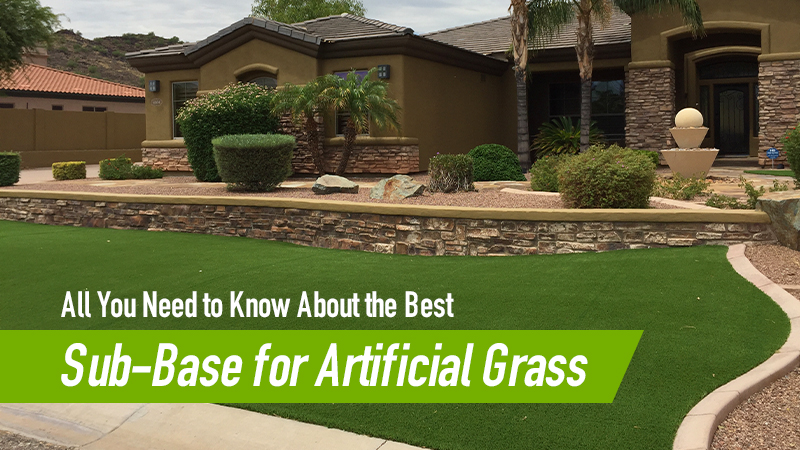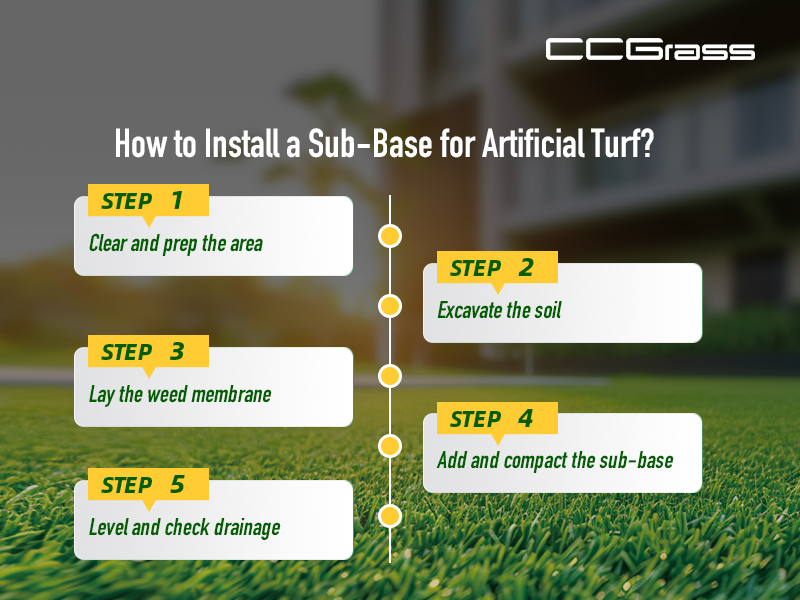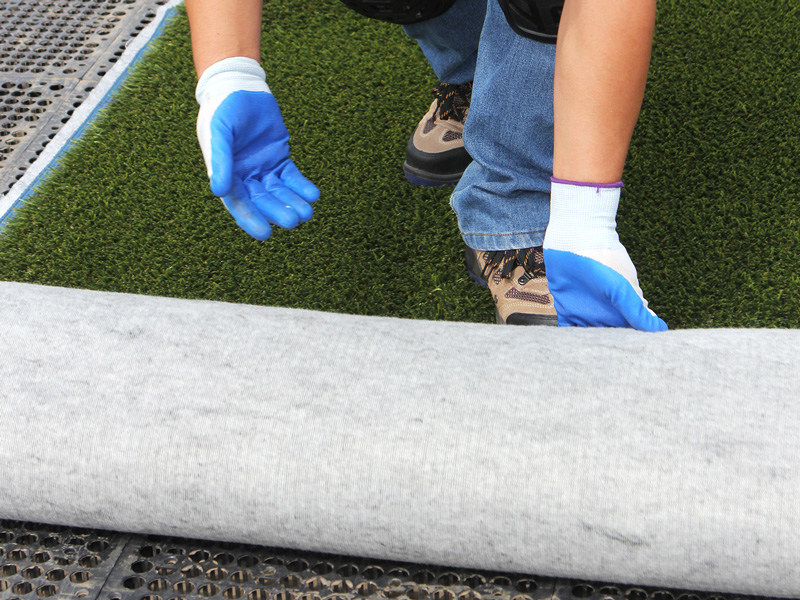All You Need to Know About the Best Sub-Base for Artificial Grass
- 03/28/2025
Can I just lay artificial turf on top of dirt? It’s a tempting shortcut, but the answer is no—unless you’re okay with uneven turf and drainage issues down the line. The real MVP here is the sub-base—a crucial layer that keeps your turf stable, well-drained, and long-lasting.
In this guide, we’ll break down why a sub-base matters, how to choose the best artificial turf base, and the key steps for installation.
In this article:
What Is an Artificial Grass Sub-Base and Why Does It Matter?
A sub-base for artificial grass is a compacted layer of material installed beneath the turf to provide essential stability, drainage, and support.
Soil naturally shifts with changes in moisture and temperature—it expands when wet and contracts when dry, which can cause artificial turf to wrinkle, sink, or shift over time. A stable sub-base acts as the unsung hero of your lawn, countering these movements and providing a solid foundation.
This layer delivers key benefits:
- Structural stability: It ensures the turf remains level and firm, capable of withstanding heavy foot traffic or the weight of outdoor furniture.
- Proper drainage: It facilitates effective water runoff, preventing pooling that could lead to moisture-related damage.
- Longevity: It enhances the turf’s lifespan by reducing wear and preventing issues such as sinking or shifting over time.
Did You Know? A proper sub-base can help your turf last 15-20 years—without it, you might need a replacement in half that time!
Choosing the Best Sub-Base for Artificial Grass
Selecting the right sub-base material is essential to a durable, high-performing artificial turf installation. Here are the top options, with pros and cons:
Crushed Miscellaneous Base (CMB)
- What it is: Recycled concrete or asphalt mixed with sand and gravel.
- Pros: Affordable, widely available, excellent drainage, easy to compact.
- Cons: Slightly rougher finish compared to alternatives.
- Best for: Most residential lawns and budget-conscious projects.
Decomposed Granite (DG)
- What it is: Weathered granite rock blended with sand and clay.
- Pros: Smoother surface, aesthetically pleasing, good stability.
- Cons: More expensive, less effective drainage than CMB.
- Best for: High-end installations like putting greens,or areas needing a polished look.
Class II Road Base
- What it is: A premium version of CMB with stricter quality standards.
- Pros: Superior durability, ideal for heavy traffic.
- Cons: Higher cost and less common availability.
- Best for: Commercial spaces or sports fields.
Quick Comparison Table:
| Material | Cost | Drainage | Durability | Best Use Case |
| CMB | Low | High | Good | Residential lawns |
| Low | Medium | Medium | Good | Putting greens, aesthetic projects |
| Class II Road Base | High | High | Excellent | High-traffic areas |
How to Install a Sub-Base for Artificial Turf?
Preparing to install your sub-base? Follow these steps to achieve a professional-grade foundation. You’ll need basic tools such as a shovel, rake, plate compactor (rentable), and measuring tape.
Step 1: Clear and prep the area
Start by thoroughly clearing the installation area of grass, weeds, rocks, and debris to create a clean foundation for your sub-base. Once clear, mark boundaries with stakes and string, spray paint, or flour to keep excavation precise, especially for larger areas.
Step 2: Excavate the soil
Excavating to the right depth is key to creating a stable, well-draining sub-base. A question many homeowners and installers ask is, “What’s the ideal artificial grass sub-base depth?” The answer depends on how the area will be used and the specific conditions of your site. Here’s how to get it just right:
- For residential lawns: Dig 3-4 inches (75-100mm). This depth works well for everyday use—like family yards or pet areas—ensuring both stability and proper drainage.
- For commercial or high-traffic areas: Go deeper with 5-6 inches (125-150mm) to support heavier wear, such as playgrounds or schools.
- Adjust based on your site: Got soft, clay-heavy soil or a wet climate? Stick to the deeper end of the range. If your soil is firm and drains well, the lower end might do the trick.
Step 3: Lay the weed membrane
Once the soil is excavated to the proper depth, take a moment to level it with a rake to smooth out any major bumps or dips. Then, roll out a permeable weed membrane (polypropylene works well) over the area, overlapping the edges by 6-12 inches to block weeds effectively, and secure it with landscape staples to hold it steady.
Pro tip: Don’t skip the weed membrane—it prevents weed growth and keeps your sub-base separate from the soil, ensuring long-term performance.
Step 4: Add and compact the sub-base
Spread your sub-base material, like CMB, in 2-inch layers, using a plate compactor after each layer to reach 90-95% compaction—firm enough that it won’t shift when you walk on it. Repeat this process until you hit the total depth required, typically 3-4 inches, depending on your project.
Now that you’ve got the sub-base ready, discover how to install your artificial grass like a pro with our complete guide.
Step 5: Level and check drainage
Smooth the surface with a rake or a straight board (screed) to make it even, then shape a gentle slope of 1-2% (about a 1-inch drop per 10 feet) to direct water away from the turf. This prevents pooling and keeps your lawn in top shape over time.
Sub-Base on Non-Soil Surfaces
While a sub-base is essential for soil to ensure stability and drainage, non-soil surfaces like concrete, asphalt, or decking often require less preparation.
Here’s when it’s still beneficial:
- Concrete: Usually stable enough for direct turf installation with adhesive. Add a thin 1-2 inch sub-base if it’s uneven or poorly drained.
- Asphalt: Stable but may need a thin padding layer to protect the turf from wear.
- Decking: Fine if structurally sound; a thin underlayment can prevent sagging.
Drainage is key—aim for a 1-2% slope to direct water away. On surfaces with limited runoff, options like perforations or grids that elevate the turf can enhance airflow and keep water from pooling.
For more on concrete setups, see Everything You Should Know about Installing Artificial Grass on Concrete.
Conclusion
A well-prepared artificial grass sub-base is the backbone of any synthetic turf setup, delivering a solid, well-draining foundation that keeps your turf looking flawless for years.
For a top-notch finish, we recommend pairing it with our premium synthetic grass—designed to elevate your lawn with lasting quality. Contact us for free samples and quotes at 86 25 6981 1666 or email us at [email protected] today!






